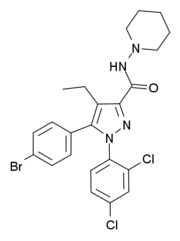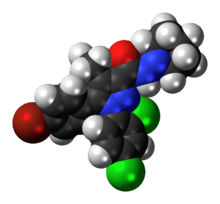Surinabant
 | |
 | |
| Clinical data | |
|---|---|
| ATC code | none |
| Identifiers | |
| |
| CAS Number |
288104-79-0 |
| PubChem (CID) | 9849616 |
| ChemSpider |
8025329 |
| UNII |
SF8R9VCB0X |
| ChEMBL |
CHEMBL189676 |
| Chemical and physical data | |
| Formula | C23H23BrCl2N4O |
| Molar mass | 522.264 g/mol |
| 3D model (Jmol) | Interactive image |
| |
| |
| | |
Surinabant (SR147778) is a cannabinoid receptor type 1 antagonist developed by Sanofi-Aventis.[1] It is being investigated as a potential treatment for nicotine addiction, to assist smoking cessation. It may also be developed as an anorectic drug to assist with weight loss, however there are already several CB1 antagonists or inverse agonists on the market or under development for this application,[2] so surinabant is at present mainly being developed as an anti-smoking drug,[3] with possible application in the treatment of other addictive disorders such as alcoholism.[4][5] Other potential applications such as treatment of ADHD have also been proposed.[6]
A dose ranging study was done for smoking cessation[7] in 2012; it did not improve success rate, but reduced weight gain. Inhibition of THC effects on heart rate was seen at 20 mg and 60 mg but not 5 mg.[8]
See also
References
- ↑ Rinaldi-Carmona, M; Barth, F; Congy, C; Martinez, S; Oustric, D; Pério, A; Poncelet, M; Maruani, J; Arnone, M; Finance, O; Soubrié, P; Le Fur, G (2004). "SR147778 [5-(4-bromophenyl)-1-(2,4-dichlorophenyl)-4-ethyl-N-(1-piperidinyl)-1H-pyrazole-3-carboxamide], a new potent and selective antagonist of the CB1 cannabinoid receptor: biochemical and pharmacological characterization". Journal of Pharmacology and Experimental Therapeutics. 310 (3): 905–14. doi:10.1124/jpet.104.067884. PMID 15131245.
- ↑ Doggrell, SA (2005). "Will the new CB1 cannabinoid receptor antagonist SR-147778 have advantages over rimonabant?". Expert Opinion on Investigational Drugs. 14 (3): 339–42. doi:10.1517/13543784.14.3.339. PMID 15833065.
- ↑ Lamota, L; Bermudez-Silva, FJ; Marco, EM; Llorente, R; Gallego, A; Rodríguez; de Fonseca, F; Viveros, MP (Jan 2008). "Effects of adolescent nicotine and SR 147778 (Surinabant) administration on food intake, somatic growth and metabolic parameters in rats". Neuropharmacology. 54 (1): 194–205. doi:10.1016/j.neuropharm.2007.07.004. PMID 17720206.
- ↑ Gessa, GL; Serra, S; Vacca, G; Carai, MA; Colombo, G (2005). "Suppressing effect of the cannabinoid CB1 receptor antagonist, SR147778, on alcohol intake and motivational properties of alcohol in alcohol-preferring sP rats". Alcohol and Alcoholism. 40 (1): 46–53. doi:10.1093/alcalc/agh114. PMID 15582988.
- ↑ Lallemand, F; De Witte, P (Jul 2006). "SR147778, a CB1 cannabinoid receptor antagonist, suppresses ethanol preference in chronically alcoholized Wistar rats". Alcohol. 39 (3): 125–34. doi:10.1016/j.alcohol.2006.08.001. PMID 17127132.
- ↑ Louis, C; Terranova, JP; Decobert, M; Bizot, JC; Francon, D; Alonso, R; Cohen, C; Griebel, G (2005). "Surinabant, a new CB1 receptor antagonist, displays efficacy in animal models of attention deficit/hyperactivity disorder". Behavioural Pharmacology. 16: S42. doi:10.1097/00008877-200509001-00133.
- ↑ "Efficacy of a dose range of surinabant, a cannabinoid receptor blocker, for smoking cessation: a randomized controlled clinical trial.". J Psychopharmacol. 26: 1003–9. Jul 2012. doi:10.1177/0269881111431623. PMID 22219220.
- ↑ "Surinabant, a selective cannabinoid receptor type 1 antagonist, inhibits Δ9-tetrahydrocannabinol-induced central nervous system and heart rate effects in humans.". Br J Clin Pharmacol. 76: 65–77. Jul 2013. doi:10.1111/bcp.12071. PMID 23278647.